2. 中国冶金地质总局山东正元地质勘查院, 济南 250101;
3. 中国地质大学地质过程与矿产资源国家重点实验室, 北京 100083;
4. 中国冶金地质总局, 北京 100131;
5. 中国地质科学院地球物理地球化学勘查研究所, 廊坊 065000
2. Geological Exploration Institute of Shandong Zhengyuan, China Metallurgical Geology Bureau, Jinan 250101, China;
3. State Key Laboratory of Geological Processes and Mineral Resources, China University of Geosciences, Beijing 100083, China;
4. China Metallurgical Geology Bureau, Beijing 100131, China;
5. Institute of Geophysical and Geochemical Exploration, Chinese Academy of Geological Sciences, Langfang 065000, China
中亚造山带是全球最大的增生型造山带(肖文交等, 2008; 王月古, 2018),因其漫长而复杂的构造演化过程,一直是国内外学者研究构造运动和岩浆活动的焦点,特别是对西伯利亚和华北板块北缘的碰撞问题进行了多方面的深入研究(Yuan et al., 2016; 王师捷等, 2018)。中亚造山带是研究金属矿产富集成矿机制的地球动力学演化的天然实验室(肖文交等, 2008; 蒋孝君, 2014; Deng et al., 2016; Shu et al., 2016; Qiu et al., 2019; Zu et al., 2019, 2020)。中亚造山带东段,即西伯利亚和华北板块之间的中国境内部分,称为兴蒙造山带。兴蒙造山带中部的锡林浩特地区、白音乌拉地区和兴蒙造山带西部的乌梁斯太地区、二连浩特-贺根山地区发育大量A型花岗质岩浆活动,对其地球化学特征、岩石成因与来源、动力学背景的研究较深入(Shi et al., 2004; 张万益, 2008; 罗红玲等, 2009; Tong et al., 2015; Zhang et al., 2015; Yu et al., 2020)。然而,有关古亚洲洋的闭合时限目前尚存在较大争议,部分学者认为松辽地体和辽源地体沿索伦-西拉木伦-长春缝合带在~250Ma的碰撞标志着古亚洲洋的闭合(Xiao et al., 2003; Wu et al., 2011);也有观点认为伴随着早石炭世蛇绿岩在二连东、贺连山等地的发育,300~330Ma大规模的花岗质岩浆活动形成于张性环境,代表后造山伸展作用(徐备等, 2014)。
乌珠新乌苏矿床位于内蒙古包头市达茂旗北约120km,大地构造上属于兴蒙造山带西段,属白乃庙-哈达庙铜金萤石成矿带(陈军强等, 2018),为近年来中国冶金地质总局山东正元地质勘查院新发现的铅多金属矿床。截止目前,已发现工业铅多金属矿体16个,主要矿体5个,主矿种为铅、锌,共生铜、金、银矿。资源储量为中型,矿床平均品位Pb 2.29%、Zn 2.44%、Cu 1.01%、Au 4.03g/t、Ag 111.2g/t。矿区内发育花岗岩体,沿索伦缝合带出露的花岗岩成岩成矿持续时限的确定,对于矿床成因与成矿作用,乃至大陆动力学演化耦合关系的认识,以及对于总结成矿规律、找矿勘探均具有至关重要的理论和实际意义(Deng et al., 2003, 2015, 2020a, b; Goldfarb et al., 2009, 2010; Groves and Bierlein, 2007; Groves et al., 2018; Shu et al., 2016; Yang et al., 2016, 2017a; 侯增谦, 2010; 高雪等, 2014; 杨立强等, 2020)。但矿区内发育的酸性侵入岩的地球化学特征、岩石成因、岩浆来源及深部动力学背景研究程度较低,这严重制约了对研究区岩浆活动与区域构造演化、深部过程的深入探讨。因此,本文主要以乌珠新乌苏花岗岩为研究对象,通过全岩主微量元素地球化学特征、LA-ICP-MS锆石U-Pb年代学、全岩Sr-Nd同位素及锆石Lu-Hf同位素等分析手段系统研究,精确厘定矿区花岗岩的侵位时代,分析其岩石地球化学属性,探讨其形成的构造环境和深部动力学过程,为进一步研究兴蒙造山带的构造-岩浆演化提供新的证据。
1 区域地质背景中亚造山带西起哈萨克斯坦,东至西伯利亚板块东部,是全球最大的显生宙陆壳增生与改造最显著的大陆造山带(图 1a, Yuan et al., 2016)。兴蒙造山带处于中亚造山带东段,其中重要的构造单元索伦缝合带通常被认为是古亚洲洋的最终缝合位置(Xiao, 2003; 孟恩等, 2011; 李可等, 2015)。缝合带南侧为南造山带,主要地质单元包括温都尔庙俯冲增生杂岩及白乃庙岛弧岩系;缝合带北侧依次划分为北造山带、二连-贺根山蛇绿混杂带和乌梁雅斯太大陆边缘带三个构造单元(图 1b, Jian et al., 2010; Yuan et al., 2016)。
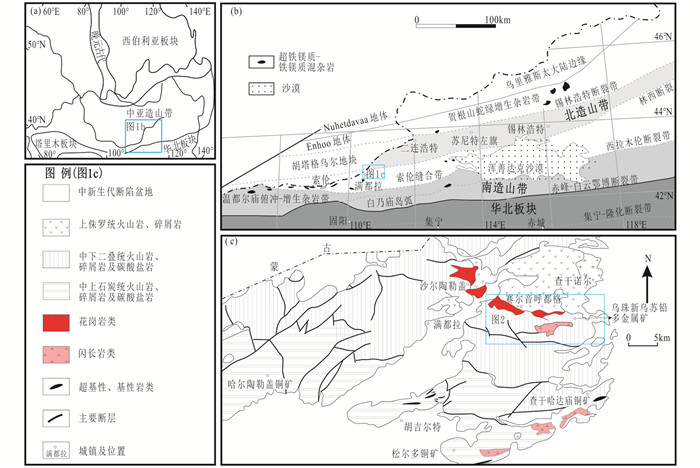
|
图 1 中亚构造示意图(a, 据Yuan et al., 2016修改)、华北板块-内蒙构造示意图(b, 据Yuan et al., 2016修改)及乌珠新乌苏矿区大地构造位置图(c, 据据汤超等, 2013修改) Fig. 1 Tectonic framework of central Asian (a, modified after Yuan et al., 2016), sketch geological map of the North China-Mongolia tract (b, modified after Yuan et al., 2016) and the tectonic location of the Wuzhuxinwusu deposit (c, modified after Tang et al., 2013) |
乌珠新乌苏多金属矿位于兴蒙造山带西段,区域出露地层从石炭系到第四系均有分布,除中新生代断陷盆地沉积的白垩系、新近纪和第四系外,出露的地层主要包括上石炭统本巴图组,岩性为砂岩、凝灰质岩、火山岩及灰岩;上石炭-下二叠统阿木山组,岩性为岩屑砂岩、粉砂岩、凝灰岩及生物碎屑灰岩;中下二叠统大石寨组和哲斯组,大石寨组为中酸性火山岩、火山碎屑岩夹黑色灰岩,哲斯组为长石砂岩、粉砂岩及生物碎屑灰岩;侏罗系,上侏罗统为火山岩及火山碎屑岩(图 1c, 汤超等, 2013)。在兴蒙造山带范围内,多种岩石-构造单元形成于二叠纪的伸展构造背景下(徐备等, 2014)。基性-超基性岩体分布于满都拉南部的胡吉尔特和查干哈达庙地区,其LA-ICP-MS锆石U-Pb年龄分别为279±3Ma和274±1Ma(晨辰等, 2012)。沿满都拉-赛尔音呼都格-乌珠新乌苏一带,花岗岩类和闪长岩类呈近东西向分布。赛尔音呼都格出露的二长花岗岩年龄为263±2.6Ma(李尚林等, 1998①),矿区周边的花岗类岩体年龄未作报道。
① 李尚林,孟二根,李新仁.1998.满都拉福1:50000区域地质调查报告
2 岩相学特征及样品概况乌珠新乌苏花岗岩沿乌珠新乌苏矿区西部的断裂带分布,出露面积约1.8km2(图 2)。
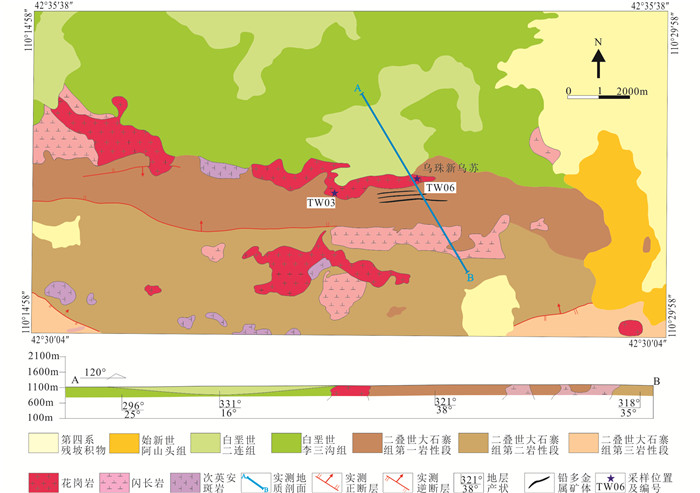
|
图 2 乌珠新乌苏铅多金属矿床地质图 Fig. 2 Regional geological map of the Wuzhuxinwusu lead polymetallic deposit |
岩石呈浅肉红色,显微文象结构,块状构造。主要由钾长石、斜长石、石英和黑云母和组成,岩石发生轻微碎裂,发育少量显微裂隙;钾长石呈他形粒状,粒径0.5~1.5mm,含量55%~60%,钾长石干涉色一级灰,多见钾长石与石英交生构成显微文象结构;斜长石呈半自形柱状,粒径多数为0.5~2mm,含量10%~15%,斜长石表面发生轻微绢云母化,干涉色一级灰,多数斜长石发育聚片双晶和卡钠复合双晶,常见斜长石边缘与石英交生构成显微文象结构,偶见斜长石内部含磷灰石包裹体;石英呈他形粒状,粒径0.1~0.75mm,含量20%~25%,石英表面干净无色,干涉色一级灰,石英呈填隙状充填于长石颗粒之间,部分石英与长石交生构成显微文象结构;石英见有挤压破碎和波状消光现象。黑云母呈半自形片状,片径0.05~1mm,含量2%~3%,具浅黄至浅褐色多色性,发育一组完全解理,干涉色被自身颜色掩盖呈浅褐色;岩石内部可见少量裂隙,裂隙宽小于0.2mm,裂隙内部多被不透明矿物和少量绢云母集合体充填(图 3)。

|
图 3 乌珠新乌苏花岗岩正交偏光镜下特征 Bt-黑云母; Qz-石英; Pl-斜长石 Fig. 3 Micropetrographic photos under cross-polarized light of the granite in Wuzhuxinwusu deposit |
本次研究所分析的样品采自内蒙古自治区达茂旗乌珠新乌苏多金属矿区22件花岗岩岩体样品,取样过程中,尽可能采集了远离矿体且未蚀变的岩石。在对所有采集样品进行岩相学观察的基础上,筛选10件进行全岩地球化学成分测试,2件进行锆石U-Pb定年,10件进行同位素测试。
3 测试方法样品经显微镜鉴定后,磨制成200目送至中国冶金地质总局山东局测试中心进行主、微量元素的测定。主量元素的分析方法为XRF方法,采用ARL 9900XP型X射线荧光光谱仪,检测温度为25℃,分析精度小于1%。微量元素分析采用ICP-MS法,将样品粉末与2%的HNO3溶解后,采用X Series2电感耦合等离子体质谱仪进行测定,检测温度为25℃。微量元素分析精度小于1%。微量元素的分析精度和准确度分别为:Th、U为0.05×10-6,Cs、Sr、Ta为0.1×10-6,Ba为0.5×10-6,Rb、Hf、Nb为0.2×10-6,Zn、Zr为2×10-6,V、Co、Ni、Cr、Cu为1.0×10-6,K、P、Ti为0.01%。稀土元素的分析精度和准确度除La、Ce、Y为0.5×10-6外,其余分析精度和准确度全0.05×10-6。
锆石单矿物的挑选、制靶和阴极发光(CL)图像、LA-ICP-MS锆石U-Pb年龄测试均在中国冶金地质总局山东局测试中心完成。锆石单矿物经破碎、重选和磁选后,在双目镜下挑选出晶形和透明度较好的锆石颗粒。制靶和阴极发光(CL)图像用环氧树脂将锆石固化后对其抛光至中心,然后通过反射光和阴极发光图像对锆石进行仔细观察并选择最佳分析点。LA-ICP-MS锆石U-Pb年龄测试分析使用的激光剥蚀束斑直径为30μm、频率为10Hz、能量密度约为8J/cm2,实验中He为剥蚀物质的载气,Ar作为补偿气。采用91500(年龄为1064±2Ma)作为外标进行基体校正;成分标样采用NIST SRM 610,其中29Si作为内标元素。样品的同位素比值及元素含量计算采用ICPMSDATACAL程序,普通铅校正采用Andersen (2002)提出的ComPbCorr#3.17校正程序,U-Pb谐和图、年龄分布频率图绘制和年龄权重平均计算采用Isoplot(Ludwig, 2003)程序完成。
锆石Lu-Hf同位素分析的锆石点均挑选自LA-ICP-MS锆石U-Pb定年的有效点。锆石Lu-Hf同位素分析在南京聚谱检测科技有限公司完成。分析采用配备193nm ArF准分子激光剥蚀系统的多接收器型号电感耦合等离子体质谱仪(MC-ICP-MS)进行测试,详细的操作过程及分析步骤见参考文献(Wu et al., 2006; Geng et al., 2017)。测试时,束斑直径为50μm,准分子激光发生器产生的深紫外光束经匀化光路聚焦于锆石表面,能量密度为3.5J/cm2,束斑直径为50μm,频率为8Hz,共剥蚀40s,剥蚀气溶胶由He送入MC-ICP-MS完成。测试过程中每隔5颗样品锆石,依次测试1颗标准锆石(包括GJ-1:0.282012;91500:0.282309;Plešovice:0.282482;Mud Tank:0.282513;Penglai:0.282906),以检验锆石Hf同位素比值数据质量。
Sr、Nd同位素组成测试在在南京聚谱检测科技有限公司完成。实验仪器为Nu Plasma II多接收器电感耦合等离子质谱仪(MC-ICP-MS)。分析采用聚四氟乙烯溶样弹,使用纯化HF-HNO3-HCL溶样,经Biorad AG50W-X8阳离子交换柱进行分离。测定过程中,86Sr/88Sr和146Nd/144Nd的比值分别采用0.1194、0.7219进行内部校正仪器质量分馏,Sr、Nd同位素分别采用国际标准物质NIST SRM 987、JNdi-1作为外标校正仪器漂移。详细的分析流程及仪器分析情况见(韦刚健等, 2002; 李壮等, 2019)。分析测试中,NIST SRM 987标准的86Sr/88Sr测定值为=0.51279±0.000017(±2σ),JNdi-1标准的146Nd/144Nd测定值为=0.703981±0.000009(±2σ)。
4 测试结果 4.1 全岩主、微量元素乌珠新乌苏花岗岩的全岩主量元素含量列于表 1中。花岗岩SiO2含量为73.13%~74.53%,平均值73.64%,显示高硅的特征;Al2O3含量为13.18%~13.49%,平均值13.38%;K2O含量较高,为4.35%~5.39%,平均值4.90%;Na2O含量略高,为2.79%~3.97%,平均值3.28%;P2O5含量较低,为0.075%~0.11%,平均值0.08%;样品具有较低的CaO(0.19%~0.89%,平均为0.51%)、MgO(0.31%~0.44%,平均为0.38%)、TiO2(0.33%~0.35%,平均为0.34%)以及较高的全铁含量(1.48%~2.52%,平均为2.04%),Mg#为11.0~13.6。
|
|
表 1 乌珠新乌苏花岗岩主量元素(wt%)和微量元素(×10-6)测试结果 Table 1 Major (wt%) and trace (×10-6) elements data of the granite in Wuzhuxinwusu deposit |
花岗岩的铝饱和指数A/CNK比值为1.49~1.56。岩石全碱TAS图解中(Middlemost, 1994)(图 4a),样品数据点均落在花岗岩区域,岩石类型与室内镜下鉴定结果一致。在SiO2-K2O的地球化学判别图解中,样品显示为高钾钙碱性系列的花岗岩(图 4b),与兴蒙造山带中西部的二连浩特-贺根山地区碱性花岗岩、锡林浩特A型花岗岩、白音乌拉A型花岗岩、乌梁斯太A型花岗岩的主量元素特征基本一致(Hong et al., 1996; Zhang et al., 2008a; 罗红玲等, 2009)。在哈克图解中,样品的SiO2与TiO2、MgO、CaO、MnO、Al2O3、P2O5的含量没有明显的相关关系(图 5)。

|
图 4 乌珠新乌苏花岗岩TAS图解(a, 底图据Middlemost, 1994)和K2O-SiO2图解(b, 底图据Rickwood, 1989) 文献数据来源:Shi et al., 2004; 张万益, 2008; 罗红玲等, 2009; Tong et al., 2015; Zhang et al., 2015.图 5、图 6、图 11、图 13文献数据来源同此图 Fig. 4 TAS diagram (a, base map after Middlemost, 1994) and K2O vs. SiO2 diagram (b, base map after Rickwood, 1989) of the granite in Wuzhuxinwusu deposit |
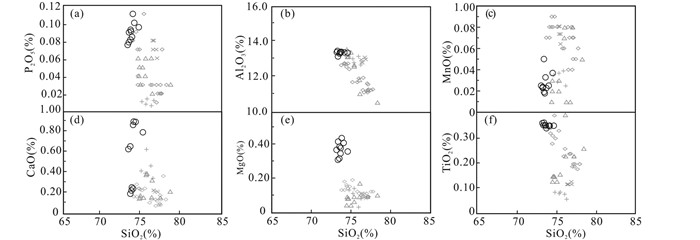
|
图 5 乌珠新乌苏花岗岩哈克图解 Fig. 5 Harker diagrams of the granite in Wuzhuxinwusu deposit |
乌珠新乌苏花岗岩的稀土总量较富集,∑REE为174.8×10-6~213.7×10-6,平均为194.2×10-6,略高于地壳岩浆岩平均值(164×10-6, 赵凯等, 2020)。LREE为143.5×10-6~182.0×10-6,平均162.2×10-6,HREE为30.49×10-6~34.78×10-6,平均32.09×10-6。LREE/HREE为4.51~5.74,平均5.05。乌珠新乌苏花岗岩的微量元素特征与兴蒙造山带中西部锡林浩特A型花岗岩、白音乌拉A型花岗岩、乌梁斯太A型花岗岩基本一致(图 6)。

|
图 6 乌珠新乌苏花岗岩球粒陨石标准化稀土元素配分图(a, 标准化值据Boynton, 1984)和原始地幔标准化微量元素蛛网图(b, 标准化值据Sun and McDonough, 1989) Fig. 6 Chondrite-normalized REE patterns (a, normalization value after Boynton, 1984) and primitive mantle-normalized trace element spider diagrams (b, normalization values after Sun and McDonough, 1989) of the granite in Wuzhuxinwusu deposit |
在球粒陨石标准化稀土元素配分图解(图 6a)中,乌珠新乌苏花岗岩呈典型的燕式分布的REE型式(张旗等, 2008; 赵凯等, 2020),具有总体右倾,LREE富集,HREE相对亏损的特点。其中,(La/Yb)N为3.68~5.41,(Ce/Yb)N为2.99~4.36,表明轻稀土分馏程度较重稀土更为显著(Deng et al., 2017)。Eu负异常较明显(δEu=0.12~0.29,平均0.20),说明岩浆演化过程中发生结晶分异作用或部分熔融过程中源区有斜长石的残留(高雪, 2018)。在原始地幔标准化微量元素蜘蛛图解显示(图 6b),乌珠新乌苏花岗岩总体富集Rb、Th、Ta、La、Nd、Hf,略微亏损Ba、Nb,强烈亏损K、Sr、P、Ti等元素。
4.2 锆石U-Pb年龄本文对2件花岗岩开展了LA-ICP-MS锆石U-Pb定年,样品编号分别为TW03和TW06。锆石U-Pb定年数据及计算结果详见表 2;锆石阴极发光图像、LA-ICP-MS U-Pb年龄一致曲线和加权平均年龄谱图见图 7。锆石CL形态特征显示,花岗岩的锆石普遍呈灰白色,半自形-自形晶,主要呈长柱状晶体,少量呈短柱状,其长轴长度为50~160μm,长短轴之比多为1:1~1:2(图 7a, d)。
|
|
表 2 乌珠新乌苏花岗岩LA-ICP-MS锆石测年数据 Table 2 Zircon age data acquired by LA-ICP-MS methods for the granite in Wuzhuxinwusu deposit |
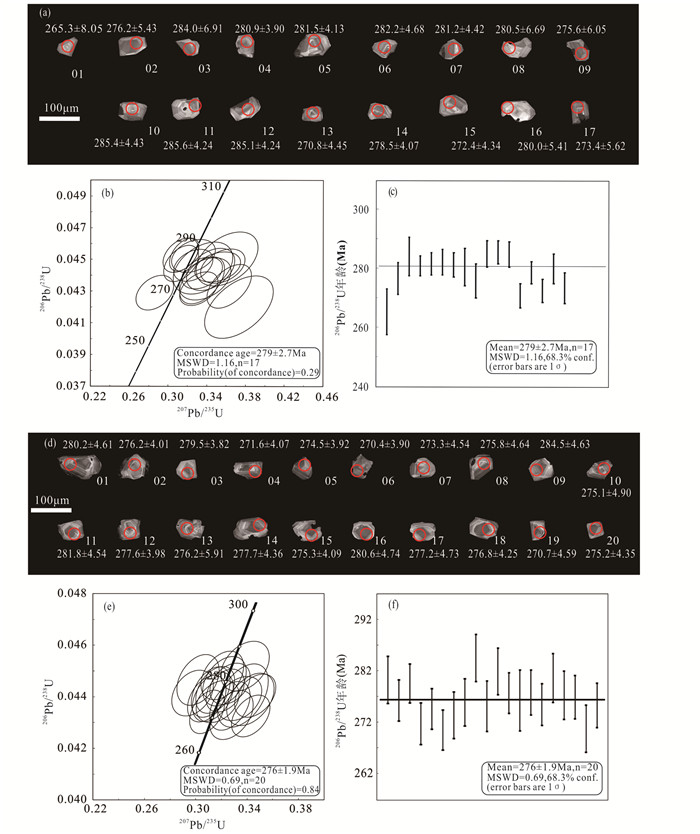
|
图 7 乌珠新乌苏花岗岩(样品TW03和TW06)锆石阴极发光图像(a、d)、LA-ICP-MS U-Pb年龄一致曲线(b、e)和加权平均年龄谱图(c、f) Fig. 7 Cathodoluminesecence images (a, d), U-Pb concordant age (b, e) and weighted mean zircon 206Pb/238U age (c, f) of the granites (Sample TW03 and Sample TW06) in Wuzhuxinwusu deposit |
花岗岩样品(TW03和TW06)共完成37个锆石点分析,Th含量为86.5×10-6~223.9×10-6,U含量为187.8×10-6~363.1×10-6,Th/U比值为0.41~0.62,具典型的岩浆锆石特征。样品(TW03)17个测点获得的206Pb/238U年龄一致曲线和加权平均结果为279±2.7Ma(MSWD=1.16)(图 7b, c);样品(TW06)20个测点获得的206Pb/238U年龄一致曲线和加权平均结果为276±1.9Ma(MSWD=0.69)(图 7e, f)。2个岩石样品的平均加权年龄在误差范围内重叠,表明此年龄值可代表岩石的结晶年龄,岩体侵位时代为早二叠世。
4.3 全岩Sr-Nd同位素乌珠新乌苏花岗岩Sr-Nd同位素组成测定结果见表 3和图 8,花岗岩的初始Sr-Nd同位素组成分别用其对应的岩石锆石U-Pb年龄值279.0Ma和276.0Ma进行校正计算。乌珠新乌苏花岗岩的87Sr/86Sr比值变化范围为0.7260~0.7359,平均值为0.7313,远高于原始地幔现在值(87Sr/86Sr=0.7045; DePaolo and Wasserburg, 1976);143Nd/144Nd变化范围为0.512387~0.512420,平均值为0.512401,略低于原始地幔现今值(143Nd/144Nd=0.512638; Jacobsen and Wasserburg, 1984)。根据U-Pb定年结果,计算获得(87Sr/86Sr)i为0.7021~0.7054,平均值为0.7035,εNd(t)介于2.1~2.7之间,平均值为2.4,二阶段Nd模式年龄为825~874Ma,平均值为854Ma。(87Sr/86Sr)i-εNd(t)图解中,样品点分布较集中,与兴蒙造山带中西部的白音乌拉A型花岗岩、二连浩特-贺根山地区碱性花岗岩部分重合(图 8b)。
|
|
表 3 乌珠新乌苏花岗岩全岩Sr-Nd同位素分析结果 Table 3 Whole-rock Sr-Nd isotopic compositions for the granites in Wuzhuxinwusu deposit |

|
图 8 乌珠新乌苏花岗岩t-εNd(t)(a)和(87Sr/86Sr)i-εNd(t)(b)(底图据Zindler and Hart, 1986; Yang et al., 2017b修改) 文献数据来源于Zhang, 2008b; Tong et al., 2015; Zhang et al., 2015 Fig. 8 The t vs. εNd(t) diagram (a) and (87Sr/86Sr)i vs. εNd(t) diagram of the granite in Wuzhuxinwusu deposit (base map modified after Zindler and Hart, 1986; Yang et al., 2017b) |
乌珠新乌苏铅多金属矿花岗岩锆石Lu-Hf同位素分析结果见表 4和图 9。花岗岩锆石初始(176Hf/177Hf)i值为0.282763~0.282884,平均值为0.282839;锆石176Yb/177Hf值为0.040465~0.079393,平均值为0.058596;锆石176Lu/177Hf值为0.001386~0.002658,平均值为0.001932,平均值小于0.0020,且大部分锆石176Lu/177Hf值小于0.0020,显示锆石在形成之后放射成因Hf的积累极为有限。176Lu/177Hf-176Hf/177Hf图解上(图 9a),样品点较集中,并且与二连浩特-贺根山地区碱性花岗岩部分重合;锆石εHf(t)值为7.7~10.2,平均值为8.5;锆石一阶模式年龄值(tDM1)为521~706Ma,平均年龄为586Ma;锆石二阶模式年龄值(tDM2)为655~931Ma,平均年龄为757Ma;fLu/Hf值为-0.96~-0.92,平均值为-0.94(图 9b)。
|
|
表 4 乌珠新乌苏花岗岩的锆石Lu-Hf同位素分析结果 Table 4 Zircon Lu-Hf isotopic data for the granites in Wuzhuxinwusu deposit |

|
图 9 乌珠新乌苏花岗岩锆石176Lu/177Hf-176Hf/177Hf关系(a)及锆石tDM2(Ma)统计直方图(b) 文献数据来源于Tong et al., 2015;图 12同 Fig. 9 Plot of 176Lu/177Hf vs. 176Lu/177Hf (a) and tDM2 (Ma) histogram (b) of zircon for the granites in Wuzhuxinwusu deposit |
乌珠新乌苏花岗岩的LA-ICP-MS锆石U-Pb年龄为279±2.7Ma和276±1.9Ma,表明该岩体侵位于早二叠世晚期。乌珠新乌苏花岗岩与索伦缝合带北缘的二叠纪A型花岗岩一致,与沿赤峰-白云鄂博的索伦缝合带南缘发育的二叠纪花岗岩相对称,它们可能均属于后碰撞阶段的产物(Shi et al., 2004; 张万益, 2008; 罗红玲等, 2009; Tong et al., 2015; Zhang et al., 2015)。此外,沿索伦缝合带北缘,从满都拉向东,二连浩特-贺根山地区的洪格尔(Hongol)和宝拉格(Baolag)花岗岩LA-ICP-MS锆石U-Pb年龄分别为275.6±1.2Ma和284.5±0.9Ma(Tong et al., 2015),白音乌拉A型花岗岩LA-ICP-MS锆石U-Pb年龄为279.2±0.9Ma(Tong et al., 2015),贺根山辉长岩、基性岩墙的SHRIMP年龄为298~295Ma(Miao et al., 2008);沿赤峰-白云鄂博的索伦缝合带南缘,狼山西段大羊圈二长花岗岩LA-ICP-MS锆石U-Pb年龄为276±2.5Ma(张永全, 2012),乌梁斯太A型花岗岩的SHRIMP年龄为277±3Ma(罗红玲等, 2009),白云鄂博花岗岩的LA-ICP-MS锆石U-Pb年龄为243.2~293.8Ma(Tong et al., 2015),四子王旗乌尔塔高勒庙角闪正长岩LA-ICP-MS锆石U-Pb年龄为271±18Ma(柳长峰, 2011),土牧尔台地区花岗闪长岩LA-ICP-MS锆石U-Pb年龄为275.3±2.6Ma(王师捷等, 2018),太仆寺卧牛山花岗闪长岩LA-ICP-MS锆石U-Pb年龄为274.7±1.2Ma(夏艳菊等, 2016),巴林左旗白音诺尔花岗(闪长)岩LA-ICP-MS锆石U-Pb年龄为272.9~275.2Ma(Shu et al., 2013)。各岩体分布的位置及测定的年龄见图 10。
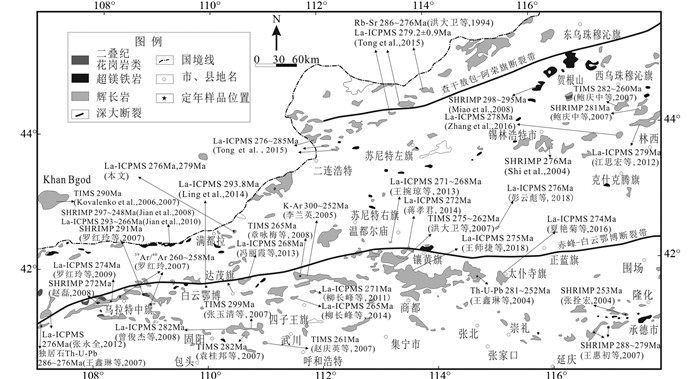
|
图 10 内蒙古中部二叠纪侵入岩分布图(据Xiao et al., 2003; 罗红玲等, 2009修改) Fig. 10 Geological map of central Inner Mongolia to show the distribution of Permian granitions (modified after Xiao et al., 2003; Luo et al., 2009) |
准确判定岩石成因类型对于深入分析岩浆源区和岩浆作用过程具有重要意义(Yang et al., 2017c; Deng et al., 2018; Qiu et al., 2020)。通常认为I型花岗岩来源于火成岩,而S型花岗岩来源于沉积岩的再熔融,M型则来自于地幔(翟明国, 2017; Qiu and Deng, 2017)。而A型花岗岩与源岩无关,代表产于伸展构造背景中高温无水的花岗岩,其以“富碱”、“无水”、“非造山”为特征,A型花岗岩最重要的地球化学特征是富SiO2,贫Al2O3、Sr、Ba、Eu、Ti和P,具有明显的负铕异常,富钾(K2O=4%~6%或更高)也是A型花岗岩最突出的特征(张旗等, 2008; 杨立强等, 2015)。从岩石类型上,A型花岗岩也可以是碱性花岗岩,同时也可能是钙碱性、弱碱-准铝、弱过铝花岗岩(许保良等, 1998)。刘昌实等(2003)将A型花岗岩划分为过碱性和铝质两类,碱性或者过碱性类花岗岩通常含有铁橄榄石、钙铁辉石、霓石、钠闪石等镁铁质矿物,而铝质花岗岩则一般出现碱性长石和斜长石两类长石为主。乌珠新乌苏花岗岩主要由石英、斜长石和钾长石组成,SiO2含量整体较高,富K2O(4.35%~5.39%,平均4.90%),CaO(0.19%~0.89%,平均0.51%)、MgO(0.33%~0.35%,平均0.34%)、TiO2(1.48%~2.52%,平均为2.04%),略微亏损Ba、Nb,强烈亏损Sr、P、Ti等元素(表 1)。乌珠新乌苏花岗岩的REE分配曲线呈现燕式分布,且具有明显的负铕异常(δEu < 0.30)(图 6a),矿物组合以及这些重要的地球化学特征与A型花岗岩比较类似(Pearce et al., 1984; Whalen et al., 1987)。在岩石成因类型判别图解(图 11a-d)中,所有样品均位于A型花岗岩区域内;样品点与兴蒙造山带中西部锡林浩特A型花岗岩、白音乌拉A型花岗岩和乌梁斯太A型花岗岩范围一致,进一步表明乌珠新乌苏花岗岩为A型花岗岩。
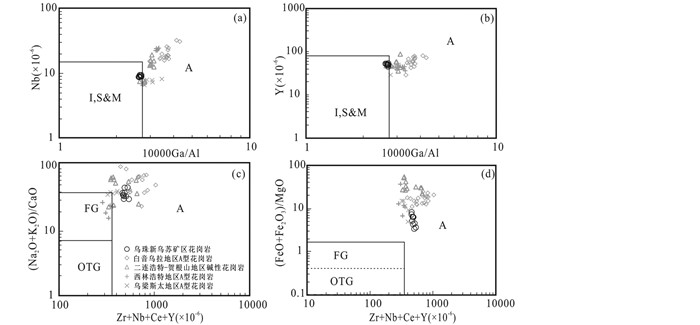
|
图 11 乌珠新乌苏花岗岩成因类型判别图解(底图据Whalen et al., 1987; 吴才来等, 2014) Fig. 11 Granite discriminant diagram of the granite in Wuzhuxinwusu deposit (base map after Whalen et al., 1987; Wu et al., 2014) |
乌珠新乌苏花岗岩中锆石的εHf(t)值较高,为+7.7~+10.2,平均值为+8.5;在t-εHf(t)图解中(图 12a)和在t-176Hf/177Hf图解中(图 12b),数据点均完全落入二连浩特-贺根山地区碱性花岗岩范围内;其中,t-εHf(t)图解中,数据点落入球粒陨石Hf同位素演化线之上,呈富集特点;t-176Hf/177Hf图解中,数据点落入球粒陨石Hf同位素演化线和亏损地幔之间区域内,呈富集特征,这表明乌珠新乌苏花岗岩为新生地壳物质部分熔融的产物。

|
图 12 乌珠新乌苏花岗岩的锆石Hf同位素图解(底图据Yang et al., 2015a, b) Fig. 12 Diagrams of Hf isotope of zircon from the granites in Wuzhuxinwusu deposit (base map modified after Yang et al., 2015a, b) |
乌珠新乌苏花岗岩的Sr含量(42.5×10-6~52.9×10-6),Yb含量(4.91×10-6~6.20×10-6),Eu负异常(0.12~0.29),符合典型南岭型花岗岩的低Sr、高Yb、Eu负异常的特点(张旗等, 2008; 罗红玲等, 2009),形成于造山后地壳减薄阶段。
在Rb-Y+Nb图解中(图 13a),样品点较集中,与兴蒙造山带中西部锡林浩特A型花岗岩、白音乌拉A型花岗岩、乌梁斯太A型花岗岩、二连浩特-贺根山地区部分重合,显示了后碰撞花岗岩的特征,且分布比较集中;在Nb-Y-Ce图解中(图 13b),样品点较集中,所有的样品点均落入A2区域,同时均落入二连浩特-贺根山地区二叠世A型花岗岩范围,也表明后碰撞花岗岩的的特征(Pearce et al., 1984; Eby, 1992; Tong et al., 2015; Wu et al., 2018)。

|
图 13 乌珠新乌苏花岗岩微量元素构造环境判别图解(底图据Pearce et al., 1984; Eby, 1992) (a) Rb-Y+Nb图解;(b) Nb-Y-Ce图解 Fig. 13 Tectonic discriminant diagrams of the granites in Wuzhuxinwusu deposit (based map after Pearce et al., 1984; Eby, 1992) |
乌珠新乌苏花岗岩的LA-ICP-MS锆石U-Pb年龄为279±2.7Ma和276±1.9Ma,表明该岩体侵位于早二叠世晚期。兴蒙造山带中部的锡林浩特地区的流纹岩和花岗岩SHRIMP年龄分别为279±3Ma和276±2Ma(Shi et al., 2004; Zhang et al., 2008b),与乌珠新乌苏花岗岩年龄一致。
乌珠新乌苏花岗岩与西乌珠穆沁旗二叠纪A型花岗岩、锡林浩特A型花岗岩、白音乌拉A型花岗岩、赛音乌苏花岗岩类的地球化学特征基本一致(Hong et al., 1996; Zhang et al., 2008b; 罗红玲等, 2009)。与索伦缝合带北侧的博格达汗(Khan Bogd)碱性花岗岩的性质类似,不同之处在于后者强烈富集稀有金属(Kovalenko et al., 2007)。岩性的差异可能与岩浆源区、岩浆熔融的物理化学条件、岩浆侵位时的混染作用、成岩过程差异以及区域上的碰撞后的伸展作用有关,但这些岩浆岩的侵位年龄集中在294~252Ma,而与俯冲相关的岩浆岩具有较长的演化历史。这些特征表明,乌珠新乌苏花岗岩与本地区的碱性花岗岩、A型花岗岩及基性-超基性岩石属于同期侵位,符合兴蒙造山带后碰撞演化阶段岩浆岩类型的多样性、巨量岩浆侵位以及岩石组合特征(肖文交等, 2008; 蒋孝君, 2014)。
6 结论(1) 乌珠新乌苏花岗岩具有富碱高钾的特征,属于高钾钙碱性系列岩石。富集大离子亲石元素K、部分高场强元素(Th、Ta、Hf)及轻稀土元素,重稀土元素亏损,Eu负异常明显。
(2) 乌珠新乌苏花岗岩的全岩(87Sr/86Sr)i比值(0.702132~0.705403)、εNd(t)值(2.12~2.69)和锆石εHf(t)(7.7~10.2)以及相对年轻的亏损地幔模式年龄(Nd的tDM2为826~874Ma;Hf的tDM2为655~931Ma),表明乌珠新乌苏花岗岩可能形成于新元古代新生地壳的部分熔融。
(3) 乌珠新乌苏花岗岩锆石LA-ICP-MS锆石U-Pb年龄为279±2.7Ma和276±1.9Ma,限定了研究区以花岗质岩浆的侵位年龄为274~282Ma,表明其形成于兴蒙造山带后碰撞演化阶段,为重建兴蒙造山带二叠纪的构造格架提供了年代学证据。
致谢 感谢杨立强教授、张良博士、熊伊曲博士、俎波博士在野外地质工作、锆石U-Pb测年过程中给予的热心帮助;衷心感谢两位匿名审稿专家提出宝贵的修改意见。
Andersen T. 2002. Correction of common lead in U-Pb analyses that do not report 204Pb. Chemical Geology, 192(1): 59-79 |
Bao QZ, Zhang CJ, Wu ZL, Wang H, Li W and Sang JH and Liu YS. 2007. Zircon SHRIMP U-Pb dating of granitoids in a Late Paleozoic rift area, southeastern Inner Mongolia, and its implications. Geology in China, 34(5): 790-798 (in Chinese with English abstract) |
Blichert-Toft J and Albarède F. 1997. The Lu-Hf isotope geochemistry of chondrites and the evolution of the mantle-crust system. Earth and Planetary Science Letters, 148(1-2): 243-258 DOI:10.1016/S0012-821X(97)00040-X |
Boynton WV. 1984. Cosmochemistry of the rare earth elements:Meteorite studies. Development in Geochemistry, 2: 63-114 DOI:10.1016/B978-0-444-42148-7.50008-3 |
Chen C, Zhang ZC, Guo ZJ, Li JF and Feng ZS and Tang WH. 2012. Geochronology, geochemistry and its geological significance of the Permian Mandula mafic rocks in Damaoqi, Inner Mongolia. Scientia Sinica (Terrae), 42(3): 343-358 (in Chinese) DOI:10.1360/zd-2012-42-3-343 |
Chen JQ, Gu AL, Li ZD, Wang JY, Wen SB and Xue BL and Gao LJ. 2018. Zircon U-Pb age, geochemistry and geological significance of the quartz diorite-porphyrite in the Habuqier gold deposit of North Damao Banner, Inner Mongolia. Geological Bulletin of China, 37(10): 1920-1932 (in Chinese with English abstract) |
Deng J, Yang LQ, Sun ZS, Wang JP, Wang QF and Xin HB and Li XJ. 2003. A metallogenic model of gold deposits of the Jiaodong granite-greenstone belt. Acta Geologica Sinica, 77(4): 537-546 |
Deng J, Wang CM, Bagas L and Carranza EJM and Lu YJ. 2015. Cretaceous-Cenozoic tectonic history of the Jiaojia Fault and gold mineralization in the Jiaodong Peninsula, China:Constraints from zircon U-Pb, illite K-Ar, and apatite fission track thermochronometry. Mineralium Deposita, 50(8): 987-1006 DOI:10.1007/s00126-015-0584-1 |
Deng J and Wang QF. 2016. Gold mineralization in China:Metallogenic provinces, deposit types and tectonic framework. Gondwana Research, 36: 219-274 DOI:10.1016/j.gr.2015.10.003 |
Deng J, Liu XF, Wang QF and Dilek Y and Liang YY. 2017. Isotopic characterization and petrogenetic modeling of Early Cretaceous mafic diking:Lithospheric extension in the North China craton, eastern Asia. GSA Bulletin, 129(11-12): 1379-1407 DOI:10.1130/B31609.1 |
Deng J, Wang CM, Bagas L and Santosh M and Yao EY. 2018. Crustal architecture and metallogenesis in the south-eastern North China Craton. Earth-Science Reviews, 182: 251-272 DOI:10.1016/j.earscirev.2018.05.001 |
Deng J, Wang QF, Santosh M, Liu XF, Liang YY, Yang LQ and Zhao R and Yang L. 2020a. Remobilization of metasomatized mantle lithosphere:A new model for the Jiaodong gold province, eastern China. Mineralium Deposita, 55(2): 257-274 DOI:10.1007/s00126-019-00925-0 |
Deng J, Qiu KF, Wang QF, Goldfarb RJ, Yang LQ, Zi JW and Geng JZ and Ma Y. 2020b. In-situ dating of hydrothermal monazite and implications on the geodynamic controls of ore formation in the Jiaodong gold province, eastern China. Economic Geology, 115(3): 671-685 DOI:10.5382/econgeo.4711 |
Depaolo DJ and Wasserburg GJ. 1976. Inferences about magma sources and mantle structure from variations of 143Nd/144Nd. Geophysical Research Letters, 3(12): 743-746 DOI:10.1029/GL003i012p00743 |
Eby GN. 1992. Chemical subdivision of the A-type granitoids:Petrogenetic and tectonic implications. Geology, 20(7): 641-644 DOI:10.1130/0091-7613(1992)020<0641:CSOTAT>2.3.CO;2 |
Feng LX, Zhang ZC, Han BF, Ren R and Li JF and Su L. 2013. LA-ICP-MS zircon U-Pb ages of granitoids in Darhan Muminggan Joint Banner, Inner Mongolia, and their geological significance. Geological Bulletin of China, 32(11): 1737-1748 (in Chinese with English abstract) |
Gao X, Deng J, Meng JY, Yan H, Li JX, Yang CH and Sun N and Wei C. 2014. Characteristics of garnet in the Hongniu skarn copper deposit western Yunnan. Acta Petrologica Sinica, 30(9): 2695-2708 (in Chinese with English abstract) |
Gao X. 2018. The Late Cretaceous polymetallic mineralization related to granitoid systems in the Yidun Terrane, East Tibet. Ph. D. Dissertation. Beijing: China University of Geosciences (in Chinese with English summary)
|
Geng JZ, Qiu KF and Gou ZY and Yu HC. 2017. Tectonic regime switchover of Triassic Western Qinling Orogen:Constraints from LA-ICP-MS zircon U-Pb geochronology and Lu-Hf isotope of Dangchuan intrusive complex in Gansu, China. Chemie der Erde-Geochemistry, 77(4): 673-651 DOI:10.1016/j.chemer.2017.05.001 |
Goldfarb RJ, Groves DI and Kerrich R and Leach DL. 2009. Metallogenic evolution on an evolving Earth. Townsville, Australia:Proceedings of the Tenth Bienniel SGA Meeting: 1-13 |
Goldfarb RJ and Bradley D and Leach DL. 2010. Secular variation in economic geology. Economic Geology, 105(3): 459-465 DOI:10.2113/gsecongeo.105.3.459 |
Griffin WL, Pearson NJ, Belousova E, Jackson SE, Van Achterbergh E and O'Reilly SY and Shee SR. 2000. The Hf isotope composition of cratonic mantle:LAM-MC-ICPMS analysis of zircon megacrysts in kimberlites. Geochimica et Cosmochimica Acta, 64(1): 133-147 DOI:10.1016/S0016-7037(99)00343-9 |
Groves DI and Bierlein FP. 2007. Geodynamic settings of mineral deposit systems. Journal of the Geological Society, 164(1): 19-30 |
Groves DI, Santosh M and Goldfarb RJ and Zhang L. 2018. Structural geometry of orogenic gold deposits:Implications for exploration of world-class and giant deposits. Geoscience Frontiers, 9(4): 1163-1177 |
Hart SR. 1984. A large-scale isotope anomaly in the Southern Hemisphere mantle. Nature, 309(5971): 753-757 |
Hong DW, Huang HZ, Xiao YJ and Xu HM and Jin MY. 1994. The Permian alkaline granites in Central Inner Mongolia and their geodynamic significance. Acta Geologica Sinica, 68(3): 219-230 (in Chinese with English abstract) |
Hong DW, Wang SG and Han BF and Jin MY. 1996. Post-orogenic alkaline granites from China and comparisons with anorogenic alkaline granites elsewhere. Journal of Southeast Asian Earth Sciences, 13(1): 13-27 DOI:10.1016/0743-9547(96)00002-5 |
Hong DW and Wang T and Tong Y. 2007. An outline about granitoids in China. Geological Reviews, 52(Suppl.): 9-16 (in Chinese with English abstract) |
Hou ZQ. 2010. Metallogensis of continental collision. Acta Geologica Sinica, 84(1): 30-58 (in Chinese with English abstract) |
Jacobsen SB and Wasserburg GJ. 1984. Sm-Nd isotopic evolution of chondrites and achondrites, Ⅱ. Earth and Planetary Science Letters, 67(2): 137-150 |
Jian P, Liu DY, Kröner A, Windley BF, Shi YR, Zhang FQ, Shi GH, Miao LC, Zhang W, Zhang Q and Zhang LQ and Ren JS. 2008. Time scale of an early to mid-Paleozoic orogenic cycle of the long-lived Central Asian Orogenic Belt, Inner Mongolia of China:Implications for continental growth. lithos, 101(3-4): 233-259 DOI:10.1016/j.lithos.2007.07.005 |
Jian P, Liu DY, Kröner A, Windley BF, Shi YR, Zhang W, Zhang FQ, Miao LC and Zhang LQ and Tomurhuu D. 2010. Evolution of a Permian intraoceanic arc-trench system in the Solonker suture zone, Central Asian Orogenic Belt, China and Mongolia. Lithos, 118(1-2): 169-190 |
Jiang SH, Liang QL and Liu YF and Liu Y. 2012. Zircon U-Pb ages of the magmatic rocks occurring in and around the Dajing Cu-Ag-Sn polymetallic deposit of Inner Mongolia and constrains to the ore-forming age. Acta Petrologica Sinica, 28(2): 495-513 (in Chinese with English abstract) |
Jiang XJ. 2014. Characteristics of Middle Permian granitoids in Jining, Inner Mongolia and their geological significance. Master Degree Thesis. Changchun: Jilin University (in Chinese with English summary)
|
Kovalenko VI, Yarmoluyk VV, Sal'nikova EB, Kozlovsky AM, Kotov AB, Kovach VP, Savatenkov VM and Vladykin NV and Ponomarchuk VA. 2006. Geology, geochronology, and geodynamics of the Khan Bogd alkali granite pluton in southern Mongolia. Geotectonics, 40(6): 450-466 |
Kovalenko VI, Yarmolyuk VV, Kozlovsky AM, Kovach VP, Sal'nikova EB and Kotov AB and Vladykin NV. 2007. Two types of magma sources of rare-metal alkali granites. Geology of Ore Deposits, 49(6): 442-466 |
Li K, Zhang ZC, Feng ZS, Li JF, Tang WH and Luo ZW and Chen Y. 2015. Two-phase magmatic events during Late Paleozoic in the north of the Central Inner Mongolia-Da Hinggan Orogenic Belt and its tectonic significance. Acta Geologica Sinica, 89(2): 272-288 (in Chinese with English abstract) |
Li LY. 2005. Geological characteristics and tectonic significance of Gonghuduge granite rock body in Siziwangqi, Inner Mongolia. Journal of Precious Metallic Geology, 14(2): 97-102 (in Chinese with English abstract) |
Li Z, Lang XH and Zhang QZ and He L. 2019. Petrogenesis and geodynamic settings of the intermediate-acid intrusions related to the Pusangguo copper-dominated polymetallic deposit in Tibet:Constrains from geochronology, geochemistry and Sr-Nd-Pb-Hf isotopes. Acta Petrologica Sinica, 35(3): 737-759 (in Chinese with English abstract) |
Ling MX, Zhang H, Li H, Liu YL, Liu J, Li LQ, Li CY and Yang XY and Sun WD. 2014. The Permian-Triassic granitoids in Bayan Obo, North China Craton:A geochemical and geochronological study. Lithos, 190-191: 430-439 DOI:10.1016/j.lithos.2014.01.002 |
Liu CF. 2010. Paleozoic-Early Mesozoic magmatic belts and tectonic significance in Siziwangqi area, Inner Mongolia. Ph. D. Dissertation. Beijing: China University of Geosciences (in Chinese with English summary) http://cdmd.cnki.com.cn/article/cdmd-11415-2010086241.htm
|
Liu CF, Zhou GZ, Zhang HF and Liu WC and Zhang L. 2011. Petrochemical characteristics and timing of Wuertagaolemiao granitoids, Siziwangqi, Inner Mongolia. Journal of Mineralogy and Petrology, 31(4): 34-43 (in Chinese with English abstract) |
Liu CF and Liu WC and Zhou GZ. 2014. Geochronology, geochemistry and tectonic setting of the Paleozoic-Early Mesozoic intrusive in Siziwangqi, Inner Mongolia. Acta Geologica Sinica, 88(6): 992-1002 (in Chinese with English abstract) |
Liu CS, Chen XM, Chen PR and Wang RC and Hu H. 2003. Subdivision, discrimination criteria and genesis for A-type rock suites. Geological Journal of China Universities, 9(4): 573-591 (in Chinese with English abstract) |
Ludwig KR. 2003. User's Manual for Isoplot 3.00: A Geochronological Toolkit for Microsoft Excel. Berkeley: Berkeley Geochronological Center, Special Publication, 1-74
|
Luo HL. 2007. On the Permian magmatism of the middle segment of the northern margin of the North China Plate and its tectonic implication. Ph. D. Dissertation. Beijing: China University of Geosciences (in Chinese with English summary)
|
Luo HL and Wu TR and Li Y. 2007. Geochemistry and SHRIMP dating of the Kebu massif from Wulatezhongqi, Inner Mongolia:Evidence for the Early Permian underplating beneath the North China Craton. Acta Petrologica Sinica, 23(4): 755-766 (in Chinese with English abstract) |
Luo HL and Wu TR and Zhao L. 2009. Zircon SHRIMP U-Pb dating of Wuliangsitai A-type granite on the northern margin of the North China Plate and tectonic significance. Acta Petrologica Sinica, 25(3): 515-526 (in Chinese with English abstract) |
Meng E, Xu WL, Yang DB, Qiu KF, Li CH and and Zhu HT. 2011. Zircon U-Pb chronology, geochemistry of Mesozoic volcanic rocks from the Lingquan basin in Manzhouli area, and its tectonics implications. Acta Petrologica Sinca, 27(4): 1209-1226 (in Chinese with English abstract) |
Miao LC, Fan WM, Liu DY, Zhang FQ and Shi YR and Guo F. 2008. Geochronology and geochemistry of the Hegenshan ophiolitic complex:Implications for late-stage tectonic evolution of the Inner Mongolia-Daxinganling Orogenic Belt, China. Journal of Asian Earth Sciences, 32(5-6): 348-370 DOI:10.1016/j.jseaes.2007.11.005 |
Middlemost EAK. 1994. Naming materials in the magma/igneous rock system. Earth-Science Reviews, 37(3-4): 215-224 DOI:10.1016/0012-8252(94)90029-9 |
Pearce JA and Harris NBW and Tindle AG. 1984. Trace element discrimination diagrams for the tectonic interpretation of granitic rocks. Journal of Petrology, 25(4): 956-983 |
Peng YB, Jiang XJ, Yan PB and Dai MJ and Xing YJ. 2018. LA-ICP-MS zircon U-Pb ages, geochemical characteristics of middle Permian Qianhuhetaolegai granite in Zhengxiangbai banner, Inner Mongolia and their tectonic significances. Geological Review, 64(6): 1379-1392 (in Chinese with English abstract) |
Qiu KF and Deng J. 2017. Petrogenesis of granitoids in the Dewulu skarn copper deposit:Implications for the evolution of the Paleotethys Ocean and mineralization in Western Qinling, China. Ore Geology Reviews, 90: 1078-1098 DOI:10.1016/j.oregeorev.2016.09.027 |
Qiu KF, Yu HC, Wu MQ, Geng JZ, Ge XK, Gou ZY and and Taylor RD. 2019. Discrete Zr and REE mineralization of the Baerzhe rare-metal deposit, China. American Mineralogist, 104(10): 1487-1502 |
Qiu KF, Yu HC, Deng J, McIntire D, Gou ZY, Geng JZ, Chang ZS, Zhu R and Li KN and Goldfarb R. 2020. The giant Zaozigou Au-Sb deposit in West Qinling, China:Magmatic- or metamorphic-hydrothermal origin?. Mineralium Deposita, 55(2): 345-362 |
Rickwood PC. 1989. Boundary lines within petrologic diagrams which use oxides of major and minor elements. Lithos, 22(4): 247-263 |
Shi GH, Miao LC, Zhang FQ, Jian P and Fan WM and Liu DY. 2004. Emplacement age and tectonic implications of the Xilinhot A-type granite in Inner Mongolia, China. Chinese Science Bulletin, 49(7): 723-729 DOI:10.1007/BF03184272 |
Shi YR, Jian P, Kröner A, Li LL and Liu C and Zhang W. 2016. Zircon ages and Hf isotopic compositions of Ordovician and Carboniferous granitoids from central Inner Mongolia and their significance for early and Late Paleozoic evolution of the Central Asian Orogenic Belt. Journal of Asian Earth Sciences, 117: 153-169 |
Shu QH, Lai Y, Sun Y and Wang C and Meng S. 2013. Ore genesis and hydrothermal evolution of the Baiyinnuo'er zinc-lead skarn deposit, Northeast China:Evidence from isotopes (S, Pb) and fluid inclusions. Economic Geology and the Bulletin of the Society of Economic Geologists, 108(4): 835-860 DOI:10.2113/econgeo.108.4.835 |
Shu QH, Chang ZS, Lai Y, Zhou YT and Sun Y and Yan C. 2016. Regional metallogeny of Mo-bearing deposits in northeastern China, with new Re-Os dates of porphyry Mo deposits in the northern Xilamulun district. Economic Geology, 111(7): 1783-1798 |
Söderlund U, Patchett PJ and Vervoort JD and Isachsen CE. 2004. The 176Lu decay constant determined by Lu-Hf and U-Pb isotope systematics of Precambrian mafic intrusions. Earth and Planetary Science Letters, 219(3-4): 311-324 |
Steiger RH and Jäger E. 1977. Subcommission on geochronology:Convention on the use of decay constants in geo- and cosmochronology. Earth and Planetary Science Letters, 36(3): 359-362 |
Sun SS and McDonough WF. 1989. Chemical and isotopic systematics of oceanic basalts:Implications for mantle composition and processes. In:Saunders AD and Norry MJ (eds.). Magmatism in the Ocean Basins. Geological Society, London, Special Publication, 42(1): 313-345 |
Tang C, Chen JQ and Liu XX and Li ZD. 2013. Magmatic activities and copper and gold mineralization in northern Damaoqi, Inner Mongolia. Geology and Exploration, 49(2): 224-235 (in Chinese with English abstract) |
Tong Y, Jahn BM, Wang T, Hong DW, Smith EI, Sun M, Gao JF and Yang QD and Huang W. 2015. Permian alkaline granites in the Erenhot-Hegenshan belt, northern Inner Mongolia, China:Model of generation, time of emplacement and regional tectonic significance. Journal of Asian Earth Sciences, 97: 320-336 DOI:10.1016/j.jseaes.2014.10.011 |
Wang HC, Zhao FQ, Li HM, Sun LX and Miao LC and Ji SP. 2007. Zircon SHRIMP U-Pb age of the dioritic rocks from northern Hebei:The geological records of Late Paleozoic magmatic arc. Acta Petrologica Sinica, 23(3): 597-604 (in Chinese with English abstract) |
Wang SJ, Xu ZY, Dong XJ and Wang WQ and Li PC. 2018. Geochemical characteristics and zircon U-Pb age of the granodiorite-norite gabbro in the northern margin of the North China Block and their formation mechanism. Earth Science, 43(9): 3267-3284 (in Chinese with English abstract) |
Wang WQ, Xu ZY, Liu ZH and Zhao QY and Jiang XJ. 2013. Early-Middle Permian tectonic evolution of the central-northern margin of the North China Craton:Constraints from zircon U-Pb ages and geochemistry of the granitoids. Acta Petrologica Sinica, 29(9): 2987-3003 (in Chinese with English abstract) |
Wang XL. 2007. Research of Dengshenmiao granitoids of Permian. Master Degree Thesis. Beijing: Peking University (in Chinese with English summary)
|
Wang YG. 2018. The tectonic significance of the Early Permian volcanic rocks in the north margin of North China Block: A case study in Siziwangqi Banner area. Master Degree Thesis. Beijing: China University of Geosciences (Beijing) (in Chinese with English summary)
|
Wei GJ, Liang XR and Li XH and Liu Y. 2002. Precise measurement of Sr isotopic composition of liquid and solid base using (LP)MC-ICPMS. Geochimica, 31(3): 295-299 (in Chinese with English abstract) |
Whalen, J B and Currie KL and Chappell BW. 1987. A-type granites:geochemical characteristics, discrimination and petrogenesis. Contributions to Mineralogy and Petrology, 95(4): 407-419 |
Wu CL, Gao YH, Lei M, Qin HP, Liu CH, Li MZ and Frost BR and Wooden JL. 2014. Zircon SHRIMP U-Pb dating, Lu-Hf isotopic characteristics and petrogenesis of the Palaeozoic granites in Mangya area, southern Altun, NW China. Acta Petrologica Sinica, 30(8): 2297-2323 (in Chinese with English abstract) |
Wu FY, Yang YH, Xie LW and Yang JH and Xu P. 2006. Hf isotopic compositions of the standard zircons and baddeleyites used in U-Pb geochronology. Chemical Geology, 234(1-2): 105-126 DOI:10.1016/j.chemgeo.2006.05.003 |
Wu FY, Sun DY, Ge WC, Zhang YB, Grant ML and Wilde SA and Jahn BM. 2011. Geochronology of the Phanerozoic granitoids in northeastern China. Journal of Asian Earth Sciences, 41(1): 1-30 |
Wu MQ, Tian BF, Zhang DH, Xu GZ and Xu WX and Qiu KF. 2018. Zircon of the No. 782 deposit from the Great Xing'an Range in NE China:Implications for Nb-REE-Zr mineralization during magmatic-hydrothermal evolution. Ore Geology Reviews, 102: 284-299 |
Xia YJ and Wu QH and Xi XS. 2016. Zircon geochronology and trace element characteristics of the Woniushan granites in Taibus Banner, Inner Mongolia, and their geological significance. Geological Bulletin of China, 35(6): 943-952 (in Chinese with English abstract) |
Xiao WJ, Windley BF and Hao J and Zhai MG. 2003. Accretion leading to collision and the Permian Solonker suture, Inner Mongolia, China:Termination of the central Asian orogenic belt. Tectonics, 22(6): 1069 DOI:10.1029/2002TC001484 |
Xiao WJ, Shu LS, Gao J, Xiong XL, Wang JB, Guo ZJ and Li JW and Sun M. 2008. Continental dynamics of the Central Asian Orogenic Belt and its metallogeny. Xinjiang Geology, 26(1): 4-8 (in Chinese with English abstract) |
Xu B, Zhao P, Bao QZ, Zhou YH and Wang YY and Luo ZW. 2014. Preliminary study on the pre-Mesozoic tectonic unit division of the Xing-Meng Orogenic Belt (XMOB). Acta Petrologica Sinica, 30(7): 1841-1857 (in Chinese with English abstract) |
Xu BL, Yan GH, Zhang C and Li ZT and He ZF. 1998. Petrological subdivision and source material of A-type granites. Earth Science Frontiers, 5(3): 113-124 (in Chinese with English abstract) |
Yang LQ, Deng J, Dilek Y, Qiu KF, Ji XZ, Li N and Taylor RD and Yu JY. 2015a. Structure, geochronology, and petrogenesis of the Late Triassic Puziba granitoid dikes in the Mianlue suture zone, Qinling orogen, China. GSA Bulletin, 127(11-12): 1831-1854 |
Yang LQ, Deng J, Qiu KF, Ji XZ, Santosh M, Song KR, Song YH, Geng JZ and Zhang C and Hua B. 2015b. Magma mixing and crust-mantle interaction in the Triassic monzogranites of Bikou Terrane, central China:Constraints from petrology, geochemistry, and zircon U-Pb-Hf isotopic systematics. Journal of Asian Earth Sciences, 98: 320-341 DOI:10.1016/j.jseaes.2014.11.023 |
Yang LQ and Gao X and He WY. 2015. Late Cretaceous porphyry metallogenic system of the Yidun arc, SW China. Acta Petrologica Sinica, 31(11): 3155-3170 (in Chinese with English abstract) |
Yang LQ, Deng J, Wang ZL, Guo LN, Li RH, Groves DI, Danyushevsky LV, Zhang C and Zheng XL and Zhao H. 2016. Relationships between gold and pyrite at the Xincheng gold deposit, Jiaodong Peninsula, China:Implications for gold source and deposition in a brittle epizonal environment. Economic Geology, 111(1): 105-126 DOI:10.2113/econgeo.111.1.105 |
Yang LQ, Deng J, Gao X, He WY, Meng JY, Santosh M, Yu HJ and Yang Z and Wang D. 2017a. Timing of formation and origin of the Tongchanggou porphyry-skarn deposit:Implications for Late Cretaceous Mo-Cu metallogenesis in the southern Yidun Terrane, SE Tibetan Plateau. Ore Geology Reviews, 81: 1015-1032 DOI:10.1016/j.oregeorev.2016.03.015 |
Yang LQ, Guo LN, Wang ZL, Zhao RX and Song MC and Zheng XL. 2017b. Timing and mechanism of gold mineralization at the Wang'ershan gold deposit, Jiaodong Peninsula, eastern China. Ore Geology Reviews, 88: 491-510 |
Yang LQ and Gao X and Shu QH. 2017c. Multiple Mesozoic porphyry-skarn Cu (Mo-W) systems in Yidun Terrane, East Tethys:constraints from zircon U-Pb and molybdenite Re-Os geochronology. Ore Geology Reviews, 90: 813-826 DOI:10.1016/j.oregeorev.2017.01.030 |
Yang LQ, Li RH, Gao X and Qiu KF and Zhang L. 2020. A preliminary study of extreme enrichment of critical elements in the Jiaodong gold deposits, China. Acta Petrologica Sinica, 36(5): 1285-1314 (in Chinese with English abstract) |
Yu HC, Qiu KF, Pang Y, Zhao ZG and Sun ZJ and Wen YT. 2020. Extension regime of the Chinese Southwestern Tianshan Mountain during Early Carboniferous:Constraints from alluvial fan of Bashisuogong Formation in Sepabayi area in Xinjiang, China. Geological Journal, 55: 2902-2914 |
Yuan GB and Wang HC. 2006. Magmatic activity and its tectonic implications:During the Early Permian in the northwestward of Wuchuan, Inner Mongolia. Geological Survey and Research, 29(4): 303-310 (in Chinese with English abstract) |
Yuan LL, Zhang XH and Xue FH and Liu FL. 2016. Juvenile crustal recycling in an accretionary orogen:Insights from contrasting Early Permian granites from central Inner Mongolia, North China. Lithos, 264: 524-539 DOI:10.1016/j.lithos.2016.09.017 |
Zeng JJ, Zheng YY, Qi JH, Dai FH, Zhang GY and Pang YC and Wu B. 2008. Foundation and geological significance of adakitic granite at Guyang of Inner Mongolia. Earth Science (Journal of China University of Geosciences), 33(6): 755-763 (in Chinese with English abstract) |
Zhai MG. 2017. Granites:Leading study issue for continental evolution. Acta Petrologica Sinica, 33(5): 1369-1380 (in Chinese with English abstract) |
Zhang Q, Wang YL, Jin WJ and Jia XQ and Li CD. 2008. Criteria for the recognition of pre-, syn- and post-orogenic granitic rocks. Geological Bulletin of China, 27(1): 1-18 (in Chinese with English abstract) |
Zhang SH. 2004. The Late Paleozoic-Early Mesozoic tectonomagmatie activities in the eastem segment of the Inner Mongolian uplift in the Yanshan tectonic belt and their geological significance. Ph. D. Dissertation. Beijing: Chinese Academy of Geological Sciences (in Chinese with English summary)
|
Zhang SH, Zhao Y and Liu JM and Hu ZC. 2016. Different sources involved in generation of continental arc volcanism:The Carboniferous-Permian volcanic rocks in the northern margin of the North China block. Lithos, 240 DOI:10.1016/j.lithos.2015.11.027 |
Zhang W and Jian P. 2008. SHRIMP dating of Early Paleozoic granites from North Damaoqi, Inner Mongolia. Acta Geologica Sinica, 82(6): 778-787 (in Chinese with English abstract) |
Zhang WY. 2008. Magmatic activity and metallogeny of East Ujimqin Banner, Inner Mongolia. Ph. D. Dissertation. Beijing: Chinese Academy of Geological Sciences (in Chinese with English summary)
|
Zhang XH, Zhang H and Tang Y and Wilde S. 2008a. Geochemistry of Permian bimodal volcanic rocks from Central Inner Mongolia, North China:Geochemistry, petrogenesis and tectonic implication. Geochimica et Cosmochimica Acta, 72(12) |
Zhang XH, Zhang HF, Tang YJ and Wilde SA and Hu ZC. 2008b. Geochemistry of Permian bimodal volcanic rocks from central Inner Mongolia, North China:Implication for tectonic setting and Phanerozoic continental growth in Central Asian Orogenic Belt. Chemical Geology, 249(3-4): 262-281 DOI:10.1016/j.chemgeo.2008.01.005 |
Zhang XH, Yuan LL, Xue FH and Yan X and Mao Q. 2015. Early Permian A-type granites from central Inner Mongolia, North China:Magmatic tracer of post-collisional tectonics and oceanic crustal recycling. Gondwana Research, 28(1): 311-327 |
Zhang YM, Zhang HF and Zhou ZG and Liu WC. 2008. Genetic and tectonics significance of the Damiao granodiorite, Siziwangqi, Inner Mongolia. Journal of Mineralogy and Petrology, 28(02): 28-38 (in Chinese with English abstract) |
Zhang YQ, He ZY and Zhang J and Chen SH. 2007. Discussion on tectonic setting of the quartz diorite in Shilanhada, northern Daqingshan Mountain in Inner Mongolia. Geological Survey and Research, 30(1): 22-26 (in Chinese with English abstract) |
Zhang YQ. 2012. The geochemistry and tectonic significance of granitioid-dioritoid rocks in the western of Langshan Mt., Inner Mongolia. Master Degree Thesis. Lanzhou: Lanzhou University (in Chinese with English summary)
|
Zhao K, Yao HZ, Wang JX, Ghebsha FG and Xiang WS and Yang Z. 2020. Zircon U-Pb geochronology and geochemistry of Koka granite and its geological significance, Eritrea. Earth Science, 45(1): 156-167 (in Chinese with English abstract) |
Zhao L. 2008. Geochemistry and tectonic implications of the Late Palaeozoic mafic-ultramafic rocks belt on the middle segment of the northern margin of the North China Plate. Ph. D. Dissertation. Beijing: Peking University (in Chinese with English summary)
|
Zhao QY, Liu ZH and Wu XW and Chen XF. 2007. Characteristics and origin of Halaheshao pluton in Daqingshan region, Inner Mongolia. Journal of Mineralogy and Petrology, 27(1): 46-51 (in Chinese with English abstract) |
Zindler A and Hart S. 1986. Chemical geodynamics. Annual Review of Earth and Planetary Sciences, 14(1): 493-571 |
Zu B, Seltmann R, Xue CJ, Wang T, Dolgopolova A, Li C, Zhou LM, Pak N, Ivleva E and Chai MC and Zhao XB. 2019. Multiple episodes of Late Paleozoic Cu-Au mineralization in the Chatkal-Kurama terrane:New constraints from the Kuru-Tegerek and Bozymchak skarn deposits, Kyrgyzstan. Ore Geology Reviews, 113: 103077 DOI:10.1016/j.oregeorev.2019.103077 |
Zu B, Xue CJ, Seltmann R, Dolgopolova A and Chi GX and Li C. 2020. Geology, geochronology, and S-Pb-Os geochemistry of the Alastuo gold deposit, West Tianshan, NW China. Mineralium Deposita |
鲍庆中, 张长捷, 吴之理, 王宏, 李伟, 桑家合, 刘永生. 2007. 内蒙古东南部晚古生代裂谷区花岗质岩石锆石SHRIMP U-Pb定年及其地质意义. 中国地质, 34(5): 790-798. DOI:10.3969/j.issn.1000-3657.2007.05.005 |
晨辰, 张志诚, 郭召杰, 李建锋, 冯志硕, 汤文豪. 2012. 内蒙古达茂旗满都拉地区早二叠世基性岩的年代学、地球化学及其地质意义. 中国科学(地球科学), 42(3): 343-358. |
陈军强, 古阿雷, 李志丹, 王佳营, 文思博, 薛宝林, 高利军. 2018. 内蒙古达茂旗北部哈布齐尔金矿床石英闪长玢岩锆石U-Pb年龄、地球化学特征及其地质意义. 地质通报, 37(10): 1920-1932. |
冯丽霞, 张志诚, 韩宝福, 任荣, 李建锋, 苏犁. 2013. 内蒙古达茂旗花岗岩类LA-ICP-MS锆石U-Pb年龄及其地质意义. 地质通报, 32(11): 1737-1748. DOI:10.3969/j.issn.1671-2552.2013.11.006 |
高雪, 邓军, 孟健寅, 闫寒, 李建新, 杨春海, 孙诺, 魏超. 2014. 滇西红牛矽卡岩型铜矿床石榴子石特征. 岩石学报, 30(9): 2695-2708. |
高雪. 2018.义敦地体晚白垩世与侵入岩有关的多金属成矿作用.博士学位论文.北京: 中国地质大学 http://cdmd.cnki.com.cn/Article/CDMD-11415-1018010985.htm
|
洪大卫, 黄怀曾, 肖宜君, 徐海明, 靳满元. 1994. 内蒙古中部二叠纪碱性花岗岩及其地球动力学意义. 地质学报, 68(3): 219-230. DOI:10.3321/j.issn:0001-5717.1994.03.001 |
洪大卫, 王涛, 童英. 2007. 中国花岗岩概述. 地质论评, 53(增刊): 9-16. |
侯增谦. 2010. 大陆碰撞成矿论. 地质学报, 84(1): 30-58. |
江思宏, 梁清玲, 刘翼飞, 刘妍. 2012. 内蒙古大井矿区及外围岩浆岩锆石U-Pb年龄及其对成矿时间的约束. 岩石学报, 28(2): 495-513. |
蒋孝君. 2014.内蒙古集宁地区中二叠世花岗岩特征及地质意义.硕士学位论文.长春: 吉林大学 http://cdmd.cnki.com.cn/Article/CDMD-10183-1014281754.htm
|
李可, 张志诚, 冯志硕, 李建锋, 汤文豪, 罗志文, 陈彦. 2015. 兴蒙造山带中段北部晚古生代两期岩浆活动及其构造意义. 地质学报, 89(2): 272-288. |
李兰英. 2005. 内蒙古四子王旗公呼都格花岗岩体地质特征及构造意义. 地质与资源, 14(2): 97-102. DOI:10.3969/j.issn.1671-1947.2005.02.004 |
李壮, 郎兴海, 章奇志, 何亮. 2019. 西藏浦桑果铜多金属矿床中酸性岩石成因及动力学背景:年代学、地球化学及Sr-Nd-Pb-Hf同位素约束. 岩石学报, 35(3): 737-759. |
柳长峰. 2010.内蒙古四子王旗地区古生代-早中生代岩浆岩带及其构造意义.博士学位论文.北京: 中国地质大学 http://cdmd.cnki.com.cn/Article/CDMD-10183-1014281754.htm
|
柳长峰, 周志广, 张华锋, 刘文灿, 张磊. 2011. 内蒙古四子王旗乌尔塔高勒庙岩体的侵位时代及岩石地球化学特征. 矿物岩石, 31(4): 34-43. DOI:10.3969/j.issn.1001-6872.2011.04.007 |
柳长峰, 刘文灿, 周志广. 2014. 内蒙古四子王旗地区古生代-早中生代侵入岩活动期次、特征及构造背景. 地质学报, 88(6): 992-1002. |
刘昌实, 陈小明, 陈培荣, 王汝成, 胡欢. 2003. A型岩套的分类、判别标志和成因. 高校地质学报, 9(4): 573-591. DOI:10.3969/j.issn.1006-7493.2003.04.011 |
罗红玲. 2007.华北板块北缘中段二叠纪的岩浆作用及构造意义.博士学位论文.北京: 中国地质大学
|
罗红玲, 吴泰然, 李毅. 2007. 乌拉特中旗克布岩体的地球化学特征及SHRIMP定年:早二叠世华北克拉通底侵作用的证据. 岩石学报, 23(4): 755-766. |
罗红玲, 吴泰然, 赵磊. 2009. 华北板块北缘乌梁斯太A型花岗岩体锆石SHRIMP U-Pb定年及构造意义. 岩石学报, 25(3): 515-526. |
孟恩, 许文良, 杨德彬, 邱昆峰, 李长华, 祝洪涛. 2011. 满洲里地区灵泉盆地中生代火山岩的锆石U-Pb年代学、地球化学及其地质意义. 岩石学报, 27(4): 1209-1226. |
彭云彪, 蒋孝君, 剡鹏兵, 戴明建, 邢亚杰. 2018. 内蒙古正镶白旗中二叠世花岗岩锆石LA-ICP-MS U-Pb年龄、地球化学特征及构造意义. 地质论评, 64(6): 1379-1392. |
汤超, 陈军强, 刘晓雪, 李志丹. 2013. 内蒙古达茂旗北部岩浆活动与铜金成矿作用. 地质与勘探, 49(2): 224-235. |
王惠初, 赵凤清, 李惠民, 孙立新, 苗来成, 冀世平. 2007. 冀北闪长质岩石的锆石SHRIMP U-Pb年龄:晚古生代岩浆弧的地质记录. 岩石学报, 23(3): 597-604. |
王师捷, 徐仲元, 董晓杰, 王挽琼, 李鹏川. 2018. 华北板块北缘中段花岗闪长岩-苏长辉长岩的锆石U-Pb年代学、地球化学特征及其形成机制. 地球科学, 43(9): 3267-3284. |
王挽琼, 徐仲元, 刘正宏, 赵庆英, 蒋孝君. 2013. 华北板块北缘中段早中二叠世的构造属性:来自花岗岩类锆石U-Pb年代学及地球化学的制约. 岩石学报, 29(9): 2987-3003. |
王鑫琳. 2007.东升庙地区二叠纪花岗岩研究.硕士学位论文.北京: 北京大学
|
王月古. 2018.华北板块北缘早二叠世火山岩的构造意义——以四子王旗地区为例.硕士学位论文.北京: 中国地质大学 https://kns.cnki.net/KCMS/detail/detail.aspx?dbcode=CMFD&filename=1018084155.nh
|
韦刚健, 梁细荣, 李献华, 刘颖. 2002. (LP)MC-ICPMS方法精确测定液体和固体样品的Sr同位素组成. 地球化学, 31(3): 295-299. DOI:10.3321/j.issn:0379-1726.2002.03.011 |
吴才来, 郜源红, 雷敏, 秦海鹏, 刘春花, 李名则, Frost BR, Wooden JL. 2014. 南阿尔金茫崖地区花岗岩类锆石SHRIMP U-Pb定年、Lu-Hf同位素特征及岩石成因. 岩石学报, 30(8): 2297-2323. |
夏艳菊, 吴堑虹, 奚小双. 2016. 内蒙古太仆寺旗卧牛山花岗岩锆石年龄、微量元素特征及其地质意义. 地质通报, 35(6): 943-952. DOI:10.3969/j.issn.1671-2552.2016.06.011 |
肖文交, 舒良树, 高俊, 熊小林, 王京彬, 郭召杰, 李锦轶, 孙敏. 2008. 中亚造山带大陆动力学过程与成矿作用. 新疆地质, 26(1): 4-8. DOI:10.3969/j.issn.1000-8845.2008.01.002 |
徐备, 赵盼, 鲍庆中, 周永恒, 王炎阳, 罗志文. 2014. 兴蒙造山带前中生代构造单元划分初探. 岩石学报, 30(7): 1841-1857. |
许保良, 阎国翰, 张臣, 李之彤, 何中甫. 1998. A型花岗岩的岩石学亚类及其物质来源. 地学前缘, 5(3): 113-124. DOI:10.3321/j.issn:1005-2321.1998.03.011 |
杨立强, 高雪, 和文言. 2015. 义敦岛弧晚白垩世斑岩成矿系统. 岩石学报, 31(11): 3155-3170. |
杨立强, 李瑞红, 高雪, 邱坤峰, 张良. 2020. 胶东金矿床中关键金属超常富集特征与机理初探. 岩石学报, 36(5): 1285-1314. |
袁桂邦, 王惠初. 2006. 内蒙古武川西北部早二叠世岩浆活动及其构造意义. 地质调查与研究, 29(4): 303-310. DOI:10.3969/j.issn.1672-4135.2006.04.009 |
曾俊杰, 郑有业, 齐建宏, 代芳华, 张刚阳, 庞迎春, 武彬. 2008. 内蒙古固阳地区埃达克质花岗岩的发现及其地质意义. 地球科学(中国地质大学学报), 33(6): 755-763. |
翟明国. 2017. 花岗岩:大陆地质研究的突破口以及若干关键科学问题——"岩石学报"花岗岩专辑代序. 岩石学报, 33(5): 1369-1380. |
张旗, 王元龙, 金惟俊, 贾秀勤, 李承东. 2008. 造山前、造山和造山后花岗岩的识别. 地质通报, 27(1): 1-18. DOI:10.3969/j.issn.1671-2552.2008.01.001 |
张拴宏. 2004.燕山构造带内蒙古隆起东段晚古生代-早中生代构造岩浆活动及其地质意义.博士学位论文.北京: 中国地质科学院 http://www.wanfangdata.com.cn/details/detail.do?_type=degree&id=Y662077
|
张维, 简平. 2008. 内蒙古达茂旗北部早古生代花岗岩类SHRIMP U-Pb年代学. 地质学报, 82(6): 778-787. DOI:10.3321/j.issn:0001-5717.2008.06.007 |
张万益. 2008.内蒙古东乌珠穆沁旗岩浆活动与金属成矿作用.博士学位论文.北京: 中国地质科学院 http://cdmd.cnki.com.cn/Article/CDMD-82501-2008177372.htm
|
章永梅, 张华锋, 周志广, 刘文灿. 2008. 内蒙古四子王旗大庙花岗岩体的成因与构造意义. 矿物岩石, 28(02): 28-38. DOI:10.3969/j.issn.1001-6872.2008.02.006 |
张永全. 2012.内蒙古狼山西段花岗岩-闪长岩类地球化学特征及其构造意义.硕士学位论文.兰州: 兰州大学 http://cdmd.cnki.com.cn/Article/CDMD-10730-1016025591.htm
|
张玉清, 贺忠银, 张健, 陈少华. 2007. 内蒙古大青山北石兰哈达石英闪长岩构造环境讨论. 地质调查与研究, 30(1): 22-26. DOI:10.3969/j.issn.1672-4135.2007.01.003 |
赵凯, 姚华舟, 王建雄, Ghebsha FG, 向文帅, 杨镇. 2020. 厄立特里亚Koka花岗岩锆石U-Pb年代学、地球化学特征及其地质意义. 地球科学, 45(1): 156-167. |
赵磊. 2008.华北板块北缘中段晚古生代镁铁-超镁铁岩的岩石地球化学特征及其构造意义.博士学位论文.北京: 北京大学
|
赵庆英, 刘正宏, 吴新伟, 陈晓峰. 2007. 内蒙古大青山地区哈拉合少岩体特征及成因. 矿物岩石, 27(1): 46-51. DOI:10.3969/j.issn.1001-6872.2007.01.009 |
 2020, Vol. 36
2020, Vol. 36











